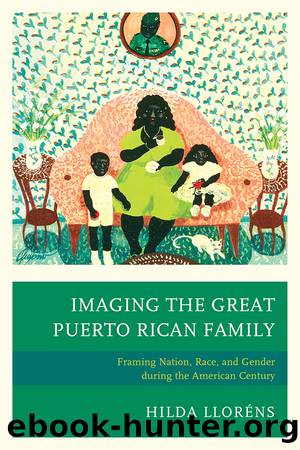Imaging the Great Puerto Rican Family by Lloréns Hilda;

Author:Lloréns, Hilda; [Lloréns, Hilda]
Language: eng
Format: epub
Publisher: Lexington Books/Fortress Academic
Published: 2014-08-15T00:00:00+00:00
Figure 5.1. Photograph of a poster taped to a town wall featuring Tufiñoâs Goyita to announce the Fiesta Negra [Black Festival], Arroyo, PR, 2009. Photo by H. Lloréns.
Tufiñoâs Goyita (1953) garnered him the honor of being called âthe Oller of the twentieth centuryâ (Tió 2002, 52). Goyita is a portrait of an aging black woman wearing a red pañuelo [headscarf]. This image has become a national icon. As a symbol of power, the red color of Goyitaâs headscarf also invokes protection for the wearer. Her wide, watery eyes stare contemplatively but directly ahead, her gaze transcending the present. Her deep-set wrinkles signal the experience of a full life. Tufiñoâs Goyita evokes Delanoâs âTenant Purchase Borrower? in her garden,â but this black woman, flanked by the working class neighborhood San José is, like Tufiño himself, resolutely urban.
In 1954, at the behest of Ricardo AlegrÃa, Tufiño applied for and later received a Guggenheim scholarship. Using the funds and time afforded by the scholarship, Tufiño produced the first ever-solo portfolio produced by a Puerto Rican artist, El café. In 1957, AlegrÃa commissioned illustrations from Tufiño for the ICPâs third Cuadernos de PoesÃa [Poetry Booklet]. This booklet featured the poetry of Palés Matos, the father of Puerto Ricoâs black poetry. Tufiño was thrilled to illustrate Palés Matos words, and the choice equally delighted the poet. Tió explains,
In A Festive Song to be Wept, the images move beyond mere illustrations to metaphorical essences of the racial and cultural realities of the Antilles. The mulata, that essence of syncretism, the lesser Antilles dancing like the classic Gracias, the masks and the caudillos, the rumba and the alienated tourism, the black dance, the voodoo, and all its magic realities. Tufiño graphically defines Palésâ Antilles. (translation mine; Tió 2001, 60)41
Among the iconic images to emerge from this undertaking is Tufiñoâs Majestad Negra (titled after Palés Matosâ poem). Tufiño depicted the âblack majestyâ walking regally, black faces appearing on the edges of the frame as they witness her strut. A year later, Tufiño painted the black majestyâs figure again and gifted the painting to the poet. As in the first illustration, she appears with her back facing the viewer, her erect and curvaceous body walking away from the edge of the frame. He used carefully blended black, gray, blue, tan, and brown tones to depict her body, the color of her skin merging with her clothes. Her thin torso and elongated arms contrast with her round behind and athletic legs. She wears blue-gray high heels. Her head, which is turned slightly upward and to the side, offers the viewer a glimpse of her fine features. Her thin nose is pointed upward her full lips are demarcated against the lighter tones of the paintingâs background. She wears an elegantly positioned orange headscarf, hoop earrings, a necklace, and bracelets. This representation offers a self-possessed black woman, in control of her body and sexuality. In the distance, against a building, Tufiño has painted a group of men. Some are drumming and others just stand.
Download
This site does not store any files on its server. We only index and link to content provided by other sites. Please contact the content providers to delete copyright contents if any and email us, we'll remove relevant links or contents immediately.
| Anthropology | Archaeology |
| Philosophy | Politics & Government |
| Social Sciences | Sociology |
| Women's Studies |
Cecilia; Or, Memoirs of an Heiress — Volume 1 by Fanny Burney(32075)
Cecilia; Or, Memoirs of an Heiress — Volume 3 by Fanny Burney(31469)
Cecilia; Or, Memoirs of an Heiress — Volume 2 by Fanny Burney(31419)
The Great Music City by Andrea Baker(30797)
We're Going to Need More Wine by Gabrielle Union(18641)
All the Missing Girls by Megan Miranda(14787)
Pimp by Iceberg Slim(13798)
Bombshells: Glamour Girls of a Lifetime by Sullivan Steve(13698)
Fifty Shades Freed by E L James(12925)
Talking to Strangers by Malcolm Gladwell(12888)
Norse Mythology by Gaiman Neil(12861)
For the Love of Europe by Rick Steves(11558)
Crazy Rich Asians by Kevin Kwan(8898)
Mindhunter: Inside the FBI's Elite Serial Crime Unit by John E. Douglas & Mark Olshaker(8720)
The Lost Art of Listening by Michael P. Nichols(7170)
Enlightenment Now: The Case for Reason, Science, Humanism, and Progress by Steven Pinker(6879)
The Four Agreements by Don Miguel Ruiz(6324)
Bad Blood by John Carreyrou(6284)
Weapons of Math Destruction by Cathy O'Neil(5845)
